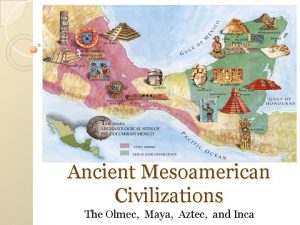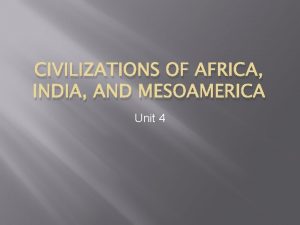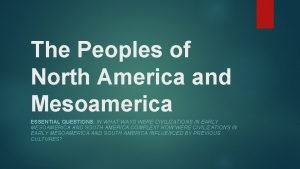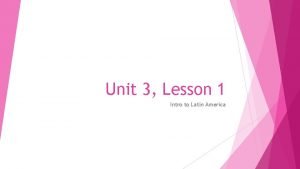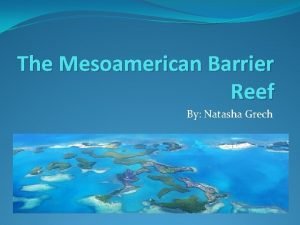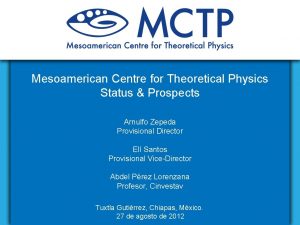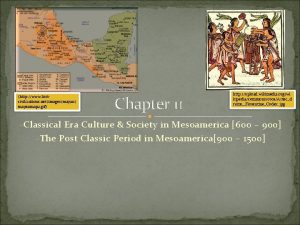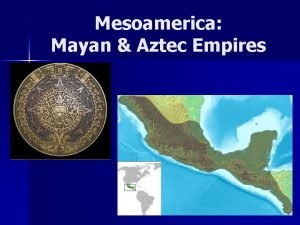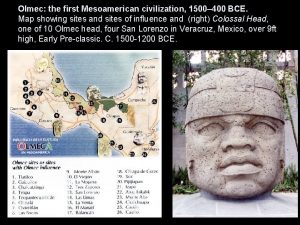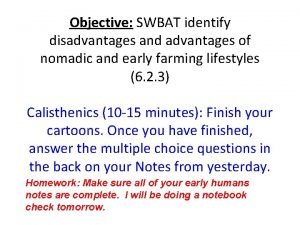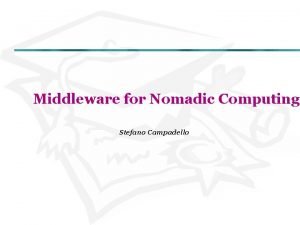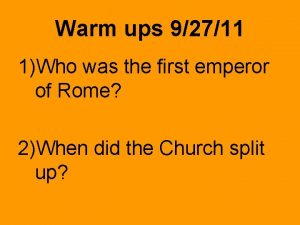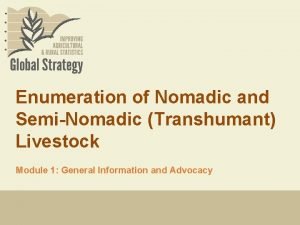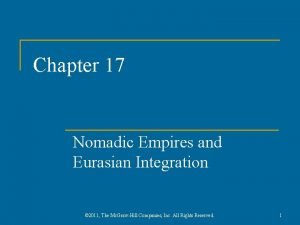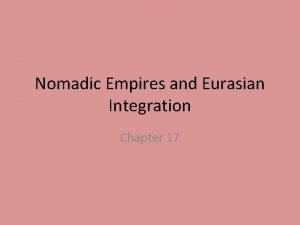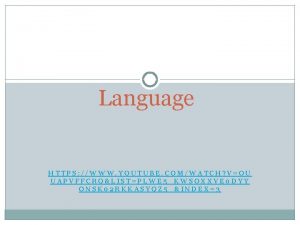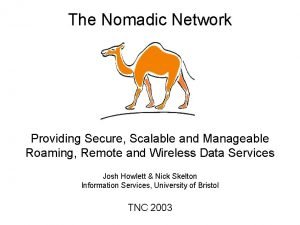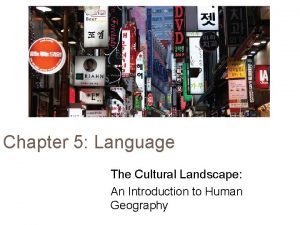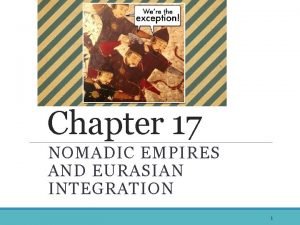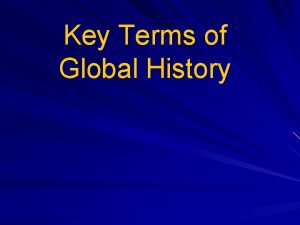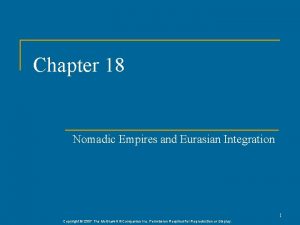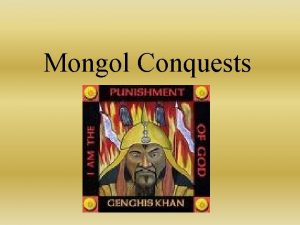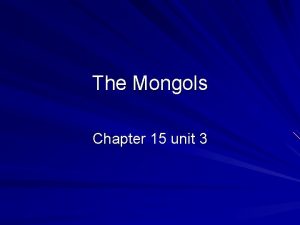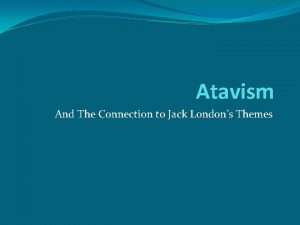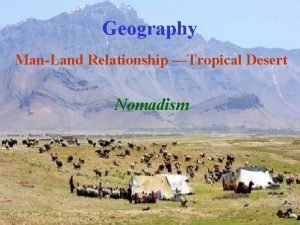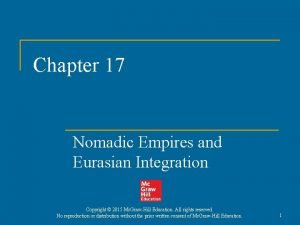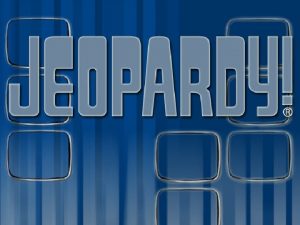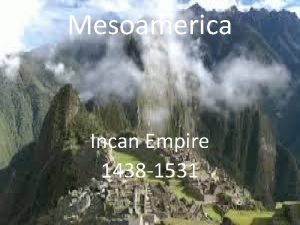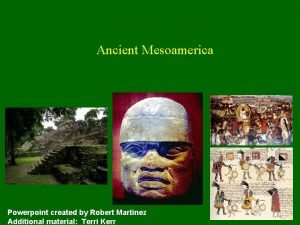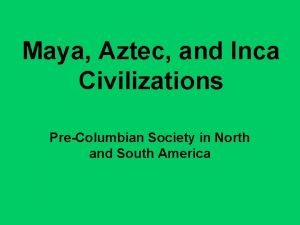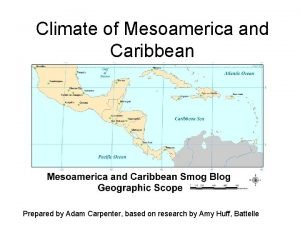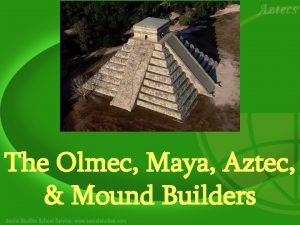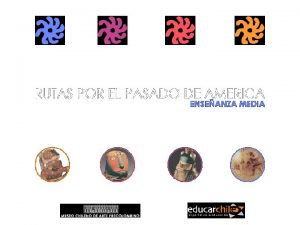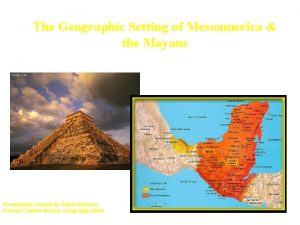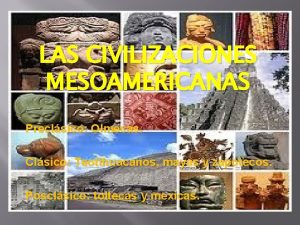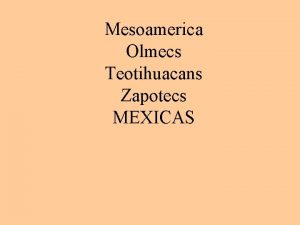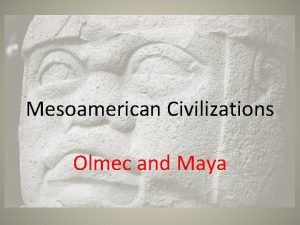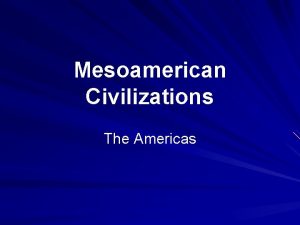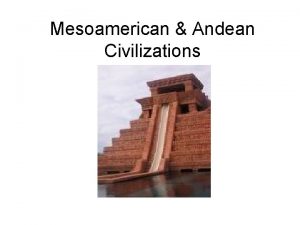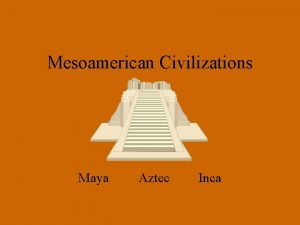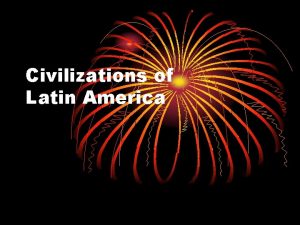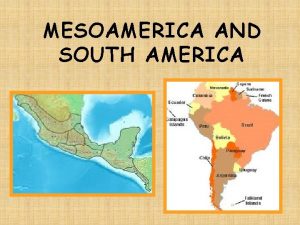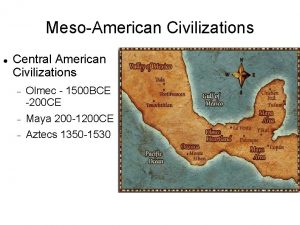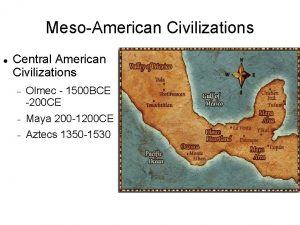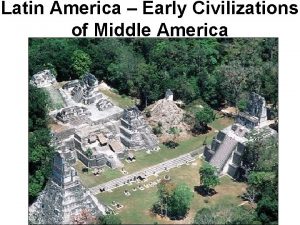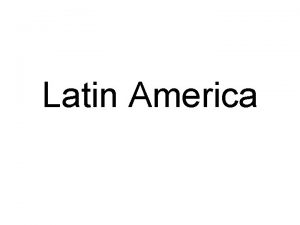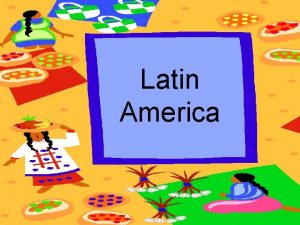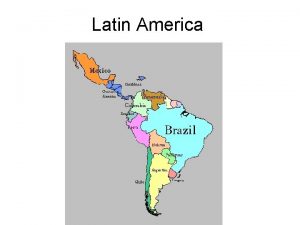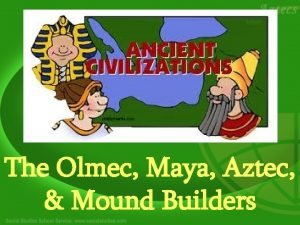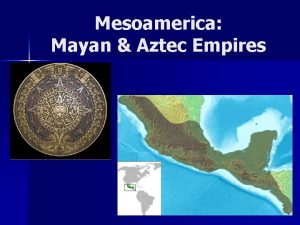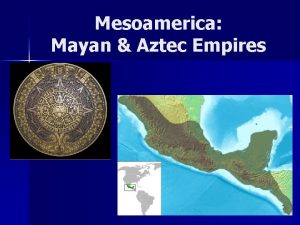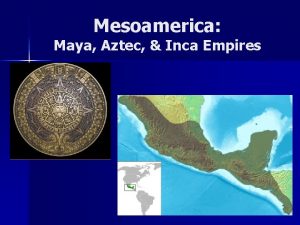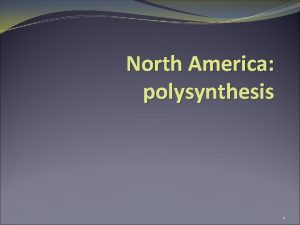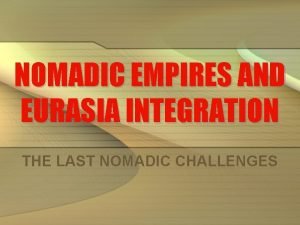Latin America Mesoamerican Civilizations Middle America Mesoamerica nomadic










































- Slides: 42

Latin America

Mesoamerican Civilizations Middle America • Mesoamerica = _________ • nomadic • Tens of thousands of years ago, ______ hunters migrated to N. and S. America from ____. (8500 BC-2000 BC) (Berengia) Asia • As people settled along ______ sources (rivers, water lakes, oceans), they domesticated animals and farming began ____ • Vast empires emerged in the Americas, including Mayas the Olmecs, Aztecs, ____, and Incas

These civilizations… • Developed ____ that supported large crops populations cities • Had organized _____ that were considered very important to their people government • Had organized ______ systems with rulers who presided over large empires complex • Were ______ civilizations: Archaeologists have uncovered evidence of advanced agriculture, engineering, and architecture

Like all the other regions we have studied… • Latin American civilizations will come into contact with Europeans during the European Age of Exploration, the effects of which are still experienced even today • The Age of Exploration (late 1400 s-1500 s) was part of the broader period of time we refer to as the Age of Old Imperialism • “When a bigger, stronger country takes over a smaller, weaker one to exploit it for its resources”

Old vs. New Imperialism Old Imperialism: 1500 s-early 1800 s (focus on New World, led by Spain & Portugal (15001600 s), followed by English, Dutch, French (1600 -1700 s), mercantilism, colonies, Columbian Exchange, Middle Passage, Age of Exploration, “God, Gold, Glory” New Imperialism: Post Industrial Imperialism, focus shifts to Africa and Asia, development of markets for industrially produced goods

The Age of European Exploration and Encounters: 1500 s • Between ____s-1700 s (Era of Old Imperialism), Europeans technology • Used modern ______ to explore trade • Found new ____ routes to the Americas • Established colonies based on mercantilist _______ policies Impact/influence • Had a lasting _______ on the Mesoamerican cultures

Key Explorers: Portugal • Spain and _______ led exploration/colonization of the Americas: Pope Demarcation Alexander II established Line of ______, dividing non-European world into 2 zones. • Spain ______ allowed to trade to the west of line, Portugal to the east. The line was then moved and allowed for both to trade under the Treaty of Tordesillas _________ in 1493 diseases • Columbus- 1492, Bahamas, _____ introduced to native populations • Magellan India • Da Gama- Sailed to _____ around Africa

The Spanish Conquistadors: Cortes • ______- 1519, Mexico, conquered Mexico in 2 years time using modern weaponry and horses Pizarro • _______- Destroyed the Incan empire of Peru (Macchu Pichu) ***These conquistadors will receive “encomiendas” from Spanish king which were large pieces of land, over which the conquistadors could oversee as they saw fit. ***

Spread of Christianity • Portuguese and Spanish spread Catholicism _______ • Great deal of influence throughout Latin Pope Francis America even today (_______) stabilizing • Catholic Church has had a _____ effect throughout history on Latin America during periods of upheaval (Revolutions, Cold War, etc) • Why are most people in Latin America Catholic colonial today? Legacy of ______ rule!

TRADE Triangular ______- Refers to the trade Americas between the continents (The _____, Europe Africa, and _____) creating a triangular shape

Former conquistadors _______rewarded by Spanish kings and queens and were given large tracts of land in New World colonies called the ______ encomiendas. “Do whatever you want with these pieces of land… _______ peopleenslave etc…” This will lead to a European dominated ______ society based on peninsular system.

Triangular Trade & Slavery: Estates/farms • Plantations- large ________ (haciendas) Africans • Slave labor- native populations used; later, _______ “recruited” as native population dies from diseases Middle Passage • The ________- the trip Africans took on their way to the New World colonies, where they were enslaved. Most died during the journey, facing unsanitary/deplorable conditions. 8 -11 • Effects of the Slave Trade: ______ million Africans sent to the Americas, Africa looses generations of people, caused local wars in Africa

Results in…The Columbian Exchange: Name given to the EXCHANGE of goods between the Old and New Worlds Columbian Exchange From Old World to New World wheat sugar bananas rice grapes horses pigs cattle sheep chickens smallpox measles typhus From New World to Old World corn potato beans peanuts squash pumpkin tomatoes avocados chili pepper pineapple cocoa tobacco quinine (a medicine for malaria)

Much of the New World Economy based on MERCANTILISM • Mercantilism: building up a nation’s wealth ______ by exporting more goods than importing. All colonies required to trade only with mother country. Merchant class of people Latin gain power in ______ America, becoming more powerful than royal landowners. • Effects of Colonization/Imperialism on Native destruction Populations: Mass ______ of culture/heritage. Diseases kill thousands, perhaps millions.

The Spanish Empire: Spain • Government: ____ maintained strict control over its empire, using viceroys to rule its provinces Catholic • Religion- The _____ Church converts thousands to Christianity, builds missions, and helped with government • Encomienda _______ System- type of mercantilism/economic structure based on Encomienda plantations in which Spanish colonies were only allowed to trade with Spain. Conquistador given land, and allowed to do whatever he wished with the people on it. Large plantations built, Enslaved/killed many native peoples ________ European • Culture- Blend of ______, Native American, and African (even today) • Social Class System: Peninsular System

Peninsular System: (Example of a HIERARCHY SOCIAL ______)

Latin American Independence Movements FRENCH Were inspired by _____ and American Revolutions, as well as Enlightenment thought throughout Europe (inspired nationalism) • Toussaint L’Ouverture- Haiti (French Colony), led a revolt. Haiti eventually becomes a republic in 1820. Bolivar • Simon _____- Early 1800 s- Led a revolt in S. America against Spanish. Called the “Liberator”, assisted with independence movements in Chile ______, Colombia, Ecuador, Peru, and Bolivia

• José de San Martín: Joined with Bolivar to Argentina defeat the Spanish in _______ and Chile in the 1810 s • Bernardo O’Higgins: Chile • Helped free _______ from Spanish rule and became ruler there

Independence Leads to Instability in Latin America: Why? barriers • Geographic ______ (vast area, Andes mountains, nationalistic leaders were often far apart from each other/made communication a bit difficult inequality • Social ______: Colonial class structure remains even after Europeans left (ex: Creoles replaced penisulares & had all of the wealth and power). oligarchy ______: ruling power belongs to a small, powerful elite: much prejudice and inequality caudillos • Military Rulers: Local _______ (military strongmen) put together their own armies and take over the government. Many became dictators

Instability in Latin America: • Power of the Church: The Catholic Church has had a unifying _______ effect on Latin America. It unifies people culturally. cash • Economic Problems: _____-crop economies (economies still dependent on a few non-food crops; if crop fails, economy fails) and economic imperialism (foreign investors/multinational companies often benefit from trade/have unequal _______ of trade at the balance expense of local populations (NON-Fair Trade chocolate & coffee, for instance) food • Population issues: Not enough ____for growing populations and crowded conditions in some big cities

Definition Nationalism: feelings of intense pride & devotion to your nation, and recognizing the things that make your nation/people unique **Nationalism in Latin America is very much connected to the concept of REGIONALISM (strong local traditions that divide people)**

EXAMPLES OF NATIONALISM & Patriotism in the USA: • Pledge of Allegiance • National Anthem • Respect for Flag **In Latin America: Nationalism has been both a “magnet” and “bomb”!** **Nationalism in Latin America is very much connected to the concept of REGIONALISM (strong local traditions that divide people)**

Bomb or Magnet Why like a bomb? (DISUNITY) It can tear groups of people apart (people recognize their differences from each other) Why like a magnet? (UNITY) It can help people realize that they have things in common and bring them together

Political and Economic Change in Latin America: (post-colonial era) • ______ and political factors have led to Social unrest maintain • Nations have struggled to _______ democracy and improve their economies trafficking • Drug ______ has continued to have an impact on the region • (lack of FAIR TRADE on the world market forces farmers to make difficult decisions: legal crops for no $$, or illegal crops, and a decent way-oflife? )

Mexico is a great example of CHANGE over time… (case example of issues facing LA Nations) • EFFECTS of MEXICAN REVOLUTION: 1910 -1917 • Mexico got rid of Diaz, a U. S. supported dictator who had been in power for almost 40 years… reforms • Social ______: established to help people. Libraries and schools were set up. Land that was taken from Indians was returned. • Economic _______: Mexico tries to make nationalism itself economically independent by industrializing. Cultural • ______ Nationalism: Writers and artists start producing more and more art to celebrate their nationality. More people took pride in Latin American culture. REGIONALISM!!!!

MEXICO (Modern History) History of Violence, uprisings, assassinations PRI • After 1917 -1970 s: _____ (Institutional • • Revolutionary Party) dominated politics 1968 ____: Student protests across Mexico Zapatista 1994: Indian ______ rebels takeover of province of Chiapas in S. Mexico (ultimately failed) PRI In 2000, Vicente Fox from ______ Action Party won presidency from PRI party Calderon 2006: Felipe ______ wins from NAP 2012: Enrique Pena Nieto from PRI current president

Problems/Causes of Unrest in Mexico: Typical of ALL Latin American Nations! Gap Between Rich & Poor European ______ groups control all of the wealth RICH ____ people opposed to reforms

Problems/Causes of Unrest in Mexico: Social Classes Upper/ruling classes of European • _______ descent Vast • _____ majority are mestizo, Native American, and African. American

Problems/Causes of Unrest in Mexico: Population and Poverty population • _____ explosion • Not enough land to grow and burn agriculture/old techniques food Slash deplete soil and destroy environment; many people are SUBSISTENCE farmers

Problems/Causes of Unrest in Mexico: Urban Growth migration • ____ of peasants to cities slums • ____ and urban shacks food • Not enough ______

ARGENTINA army Juan Perón: Former ____ colonel who supported an idea called import substitution. Limited foreign-run businesses (made native populations like him, at first). He boosted wages, helped labor unions, and established socialist welfare programs (example of a _____ program). However, he ruled as a dictator and totalitarian his government was _____. In 1955, he was overthrown in a military coup.

Many LA Nations experienced same patterns following independence: (write this wherever you can in packet) Independence Interim/Provisional Government Coup d’etat (military takeovers) Military strongmen in power (caudillos) Rebel Groups fighting against dictatorship Cold War “battle ground” (USA supports nations who agree with our foreign policy; Soviets back those who oppose USA) • History of USA supporting some “shady” people/families/dictators (as long as they are in our camp) • • •

ARGENTINA After a series of other leaders, a military regime took power in______. Government attacked 1972 leftist guerilla groups during a period of time Dirty War that became known as the _____, in which people simply disappeared (as many as 20, 000). Many mothers silently marched in Buenos ____ Aires holding pictures of their children. (STING’s song: “They Dance Alone”)

Coup d’etat… Napoleon starts the trend… #i. Tookover…#btw. Elbastinks • What’s That Mean? • COUP: A government overthrow, usually using the military to get rid of a leader. Usually ends with another dictator taking over. • Many Latin American nations have been taken over by caudillos (dictators)

GUATEMALA Arbenz Jacobo _____: Leader who the USA helped to overthrow during the Cold War, in 1954 (his land reform policies were threatening civil US business ventures). A _______ war resulted: Indigenous Indians suffered. 30, 000 die in the fighting. Peace accord reached in 1996 _____.

El SALVADOR civil Throughout much of the Cold War, _______ War between left-wing communists and right-wing revolutionaries who murdered anyone associated socialists with the left (____/communists). Because of the US desire to stop the potential spread of communism, we supported the right-wing murderous regime (but told them to “play nice”). 1996 In _______, at end of Cold War, both sides stopped fighting and agreed to peace. They are still struggling to maintain stability today.

NICARAGUA Somoza • 1936 -1979: _____ Family (oligarchy) ruled. Somozas murdered many people/were repressive. U. S. gave them weapons and support because they were anti-communist. fought (Example of how we indirectly “_____” the Soviets and their influence during the Cold War) Sandanistas • In 1979, ______ (Communist group supported by the Soviets) overthrew the Ortega Somozas. They were led by Daniel _____. Had close ties with Cuba, another communist nation.

NICARAGUA • USA couldn’t stand that there was too much Soviet influence in Central/_______ America. Latin We supported a group of rebels, called the contras ______ (counterrevolutionary group) during a civil war between the Contras & Sandanistas. 1996 • In _____, the civil war ended, and Violeta Chamorro was freely elected. Economy is still suffering.

PANAMA • Late 1980 s: USA suspects that Manuel ______ assisting drug ______ cartels Noriega (criminal gangs) to smuggle drugs into the USA • USA invades in 1989 and arrest Noriega • Panama Canal: Contructed in 1900 s. US controlled from 1914 -2000 (after treaty 1970 s signed in _____)

Obstacles to Development in Latin America: Geographic • ________ features, uncertain rainfall, lack of fertile land, mountain ranges, distances • Population Growth (crowded cities in some areas, not enough food to growing sustain ______ population) • cash ______ crops: led to economic dependence on other nations after post-colonial era • Trade ________ Imbalances/unfavorable balances of trade • political ______ instability (civil wars, uprisings, rebel groups, drug trade) • Environmental _______: Amazon rain forest exploited for economic profit; millions of acres of land destroyed each year (slash and burn technique), _______ of the soil leaching • pollution ________ from industrialization sanitation • Lack of _________ in some places • Peninsular ______ system established during European colonization persists even today (divisions between wealthy and poor)

NAFTA ________: North American Free Trade Agreement • Agreement between the USA, Canada, and Mexico ________ to compete with the _______ Union and improve European economies in the 1990 s MOVED • Some US businesses have ______ to Mexico for cheap labor (Global economics/globalization) • Some believe this helps Mexico, but hurts the USA ______ (losing U. S. jobs)

• CUBA 1959: Communist Revolution. Difficult history with USA the _____. FIDEL • ________ Castro has ruled since 1959 (Cuban Revolution). Today: Castro’s brother, Raul Castro, is current president due to Fidel’s recent illnesses (2010) Cold War • _______ Conflict Area: Cuban Missile Crisis (1962) & Bay of Pigs Invasion ally • Was an ____ of the Soviet Union during the Cold War command economy under Castro, although • Established a _____ has become more of a mixed economy post Cold War
 Timeline of olmec maya aztec inca
Timeline of olmec maya aztec inca Quipus
Quipus Why is called latin america
Why is called latin america The peoples of north america and mesoamerica
The peoples of north america and mesoamerica Chapter 14 lesson 2 early south american civilizations
Chapter 14 lesson 2 early south american civilizations Lesson 1 latin america africa and the middle east
Lesson 1 latin america africa and the middle east Natasha grech
Natasha grech Mesoamerican centre for theoretical physics
Mesoamerican centre for theoretical physics Mesoamerica society
Mesoamerica society Climate of the aztec empire
Climate of the aztec empire First mesoamerican civilization
First mesoamerican civilization Advantages and disadvantages of nomadic herding
Advantages and disadvantages of nomadic herding Nomadic computing examples
Nomadic computing examples Why do geographers call arabia a crossroads location
Why do geographers call arabia a crossroads location Nomadic invaders
Nomadic invaders Semi nomadic definition
Semi nomadic definition Chapter 17 nomadic empires and eurasian integration
Chapter 17 nomadic empires and eurasian integration Nomadic religion
Nomadic religion Sedentary farmer theory
Sedentary farmer theory Nomadic network
Nomadic network Language cultural landscape
Language cultural landscape The nomadic network
The nomadic network Chapter 17 nomadic empires and eurasian integration
Chapter 17 nomadic empires and eurasian integration Dharma
Dharma Chapter 18 nomadic empires and eurasian integration
Chapter 18 nomadic empires and eurasian integration Nomadic user disebut juga
Nomadic user disebut juga Nomadic peoples who herded domesticated animals
Nomadic peoples who herded domesticated animals Chapter 15 the last great nomadic challenges
Chapter 15 the last great nomadic challenges Atavism poem
Atavism poem Nomadic herding definition ap human geography
Nomadic herding definition ap human geography Chapter 17 nomadic empires and eurasian integration
Chapter 17 nomadic empires and eurasian integration Islamic jeopardy questions
Islamic jeopardy questions Día de la independencia del perú
Día de la independencia del perú Terrace farming mesoamerica
Terrace farming mesoamerica Pisos ecológicos
Pisos ecológicos Mesoamerica powerpoint
Mesoamerica powerpoint Mesoamerica inca
Mesoamerica inca Climate in mesoamerica
Climate in mesoamerica Causeway mesoamerica
Causeway mesoamerica Mesoamerica inca
Mesoamerica inca Mesoamerica culturas
Mesoamerica culturas Geography of mesoamerica
Geography of mesoamerica Teotihuacanos mayas y zapotecos
Teotihuacanos mayas y zapotecos
